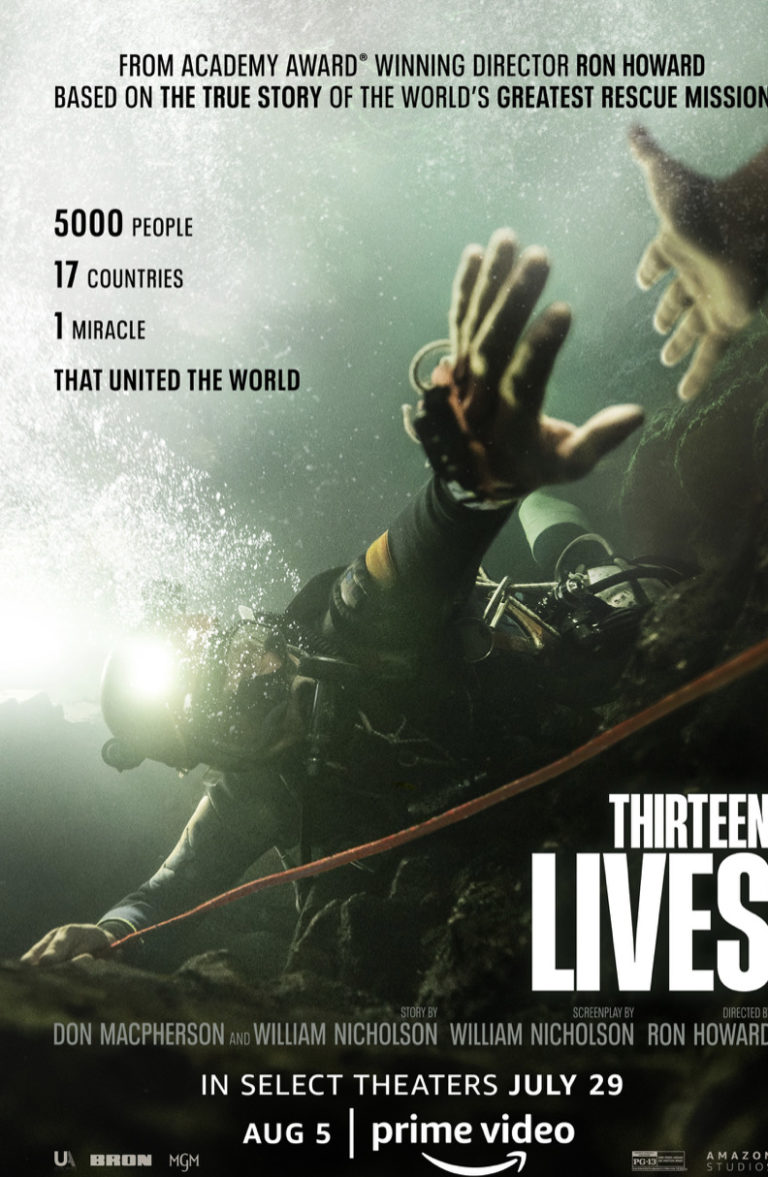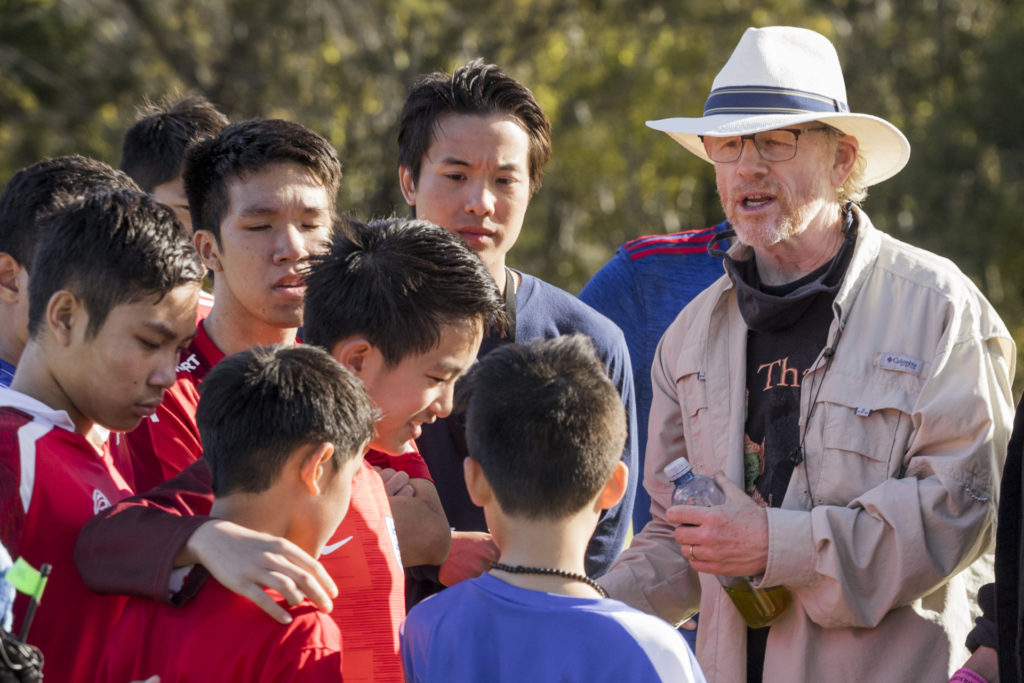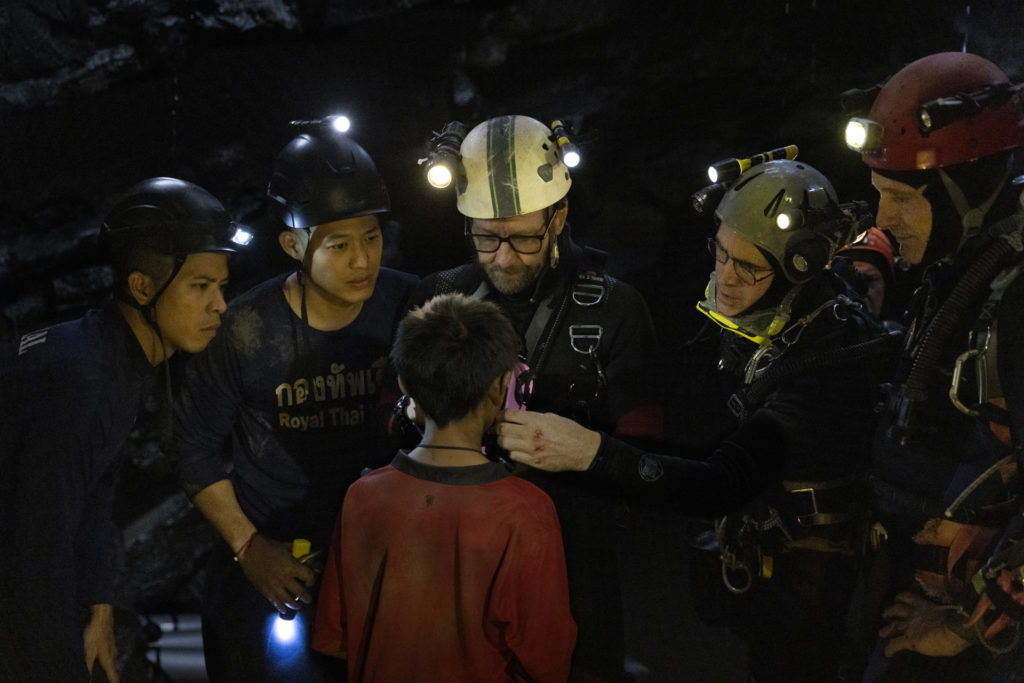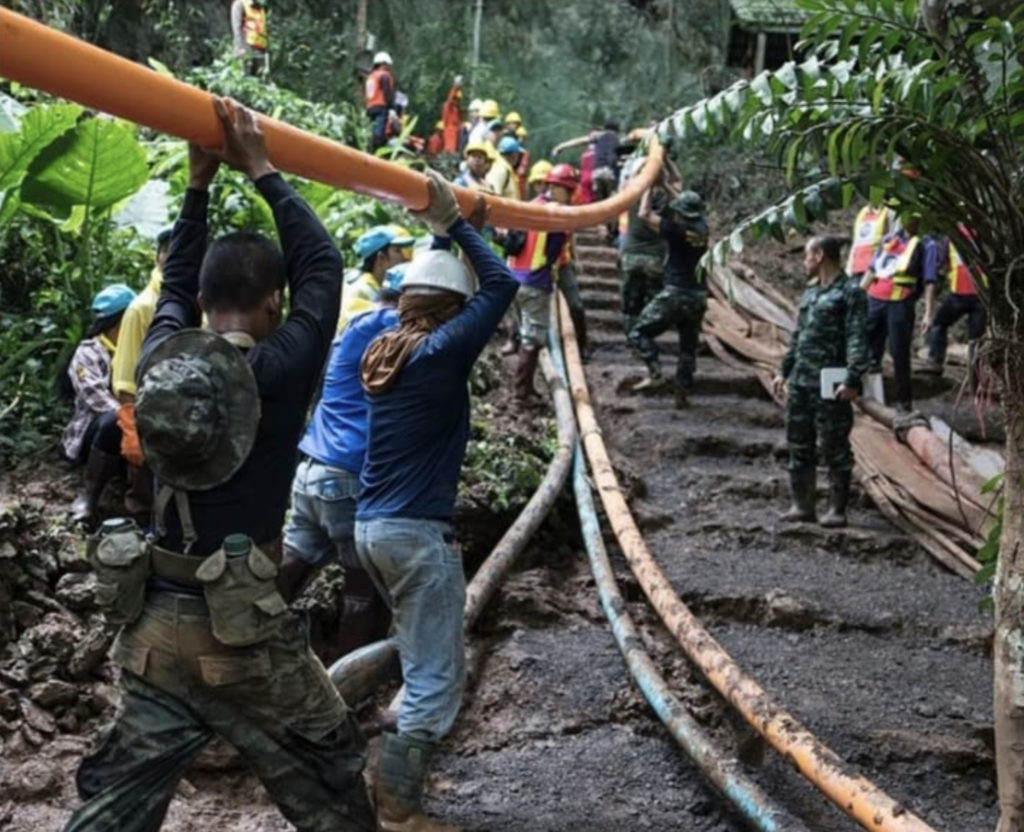
Synopsis :Thirteen Lives recounts the incredible true story of the tremendous global effort to rescue a Thai soccer team who become trapped in the Tham Luang cave during an unexpected rainstorm. Faced with insurmountable odds, a team of the world’s most skilled and experienced divers — uniquely able to navigate the maze of flooded, narrow cave tunnels — join with Thai forces and more than 10,000 volunteers to attempt a harrowing rescue of the twelve boys and their coach. With impossibly high stakes and the entire world watching, the group embarks on their most challenging dive yet, showcasing the limitlessness of the human spirit in the process.
Q: Director Ron Howard is joined here with some of the actors from the film. First, we have Viggo Mortensen playing Rick Stanton and Colin Farrell as John Volanthen. We have Joel Edgerton as Harry Harris and Tom Bateman as Chris Jewell. We also have James Teeradon, who plays the coach of the soccer team, Ploy Pattrakorn, who’s the mother of one of the trapped boys, Boo Sahajak [PH] who plays the governor of Thailand. And we also have Two Popetorn who plays Dr. Karn, a Thai Navy SEAL.
Q: Viggo, you play a real-life person in this, and you have the guy you’re playing being on set, monitoring your moves. It’s an added approach. Is this the first time you’ve had a real-life counterpart on set with you?
Viggo: No, but in this case, it was crucial. Especially for what we had to do underwater. Rick Stanton was there during rehearsals with all the actors; Jason also came as one of the real-life rescuers. They helped us to not only swim like them and move like them but to be safe. And the way we worked as a team reflected what they described to us, what the rescue entailed. We really worked together above water as much as underwater.
And underwater, I would say it was maybe even more important because even though you’re shooting a movie, and it’s a somewhat controlled situation, whenever you’re underwater, and in caves, it’s dangerous. So I think with all the actors, we listened very carefully to what they were showing us, telling us, and watched what they did very carefully.
Everybody worked hard and pulled together. It reflected the real rescue in that it was a very selfless, team-oriented effort. Shooting the movie as well. So it felt at times very real. Sometimes too real. There were some very tight spots underwater.
Q: There are things that are difficult to work with on a film set — and water is the great equalizer. Colin, you’ve done big movies like grand, sweeping epics. But with this one, you’re playing a real-life person. Was there something about this particular role that changed your approach as far as how you had to prepare because it was kind of like an action movie and a biopic all in one.
Colin: You know, they say don’t work with children or animals. Throw water into that mix as well. I can’t really swim, so there’s an element of not swimming in what we were doing. Something about scuba diving is that you accept the process of not drowning but submerging. It’s a different world beneath the surface of the water. And like what Viggo was saying and what Ron touched on as well, I felt like I was one spoke of many in a story that was so multi-faceted. The burden, which was also an honor, were one and the same and that was that we were telling this tale of events that really took place.
We are representing lives that exist today. Obviously, They were the first ones mentioned, but also two lives were lost as a result. One directly during the rescue, Saman, a Thai diver. Another man lost his life as a result of an infection [he had] months later after the dive. So the responsibility is to honor the lives that passed and not just the spirit of those who survived the rescue, who were for the many, surprisingly, was something that was a burden.
It’s an honor [as well]. And we were really aware of it. It wasn’t about us coming in as actors playing these British divers who were there to save the day and rescue. It was really about us being led by our Thai brothers and sisters, and those people who we were playing as well — the divers — and how they guided us through the actual events that took place, how serious it was.
I’ve done various things throughout my career but to be part of something that ultimately, at its core was — and in a time where the world seems to be living under greater division — really about these people from different nationalities, and cultural backgrounds coming together for a common purpose, one that was so terrifying. It was a great gift.
We felt that spirit of collaboration and harmony the whole way throughout the shoot, and that was honestly, a joy, apart from how nervous I was going under the water every day because some of it was terrifying. As Viggo said, it was as controlled an environment as it could be, but, water is wet no matter how much control you have or don’t have. It was pretty extraordinary that we were able to give them the opportunity to do the things that we were given to do. That’s a testament to Ron’s desire to be as detailed, and factual and honor the story in that way as well.
Q: I want to add that for James and Boo that describes your involvement in this both as Thai actors who have had careers well before joining this film, but knowing what this film has the potential to do as far as [reaching] a global audience, and knowing that you not only represent this as people of the Thai culture, but [also represent those] within the film itself. How did you approach this experience because it’s a mix of so many emotions? Boo, I’ll start with you.
Boo: This has been a great experience for all of us Thai actors. The honor of being able to tell our story through Ron’s film, and it feels like we have that responsibility to just do a really good job for all of us Thai people. And it’s just been a great ride, and we just enjoyed every moment of it.
Q: James, a lot of your time was spent with these young actors and literally, a lot of them this is their very first performance. That is another thing added to what Colin alluded to [about the] kids. You put the kids in water, there’s all sorts of things that you guys added to this tall order. How was that for you, guiding them — as well as yourself — through this process?
James: It’s quite hard for me because I’m not a very kind person, but I’m actually working with them. I really respect them because I can see they’re passionate, cute boys. Every time I work with them and come to the scene with them, they show me something that inspires me to make it good and better. I actually worked with the boys. It’s a good opportunity for me and I love them so much. They’re very cute.

Credit: Vince Valitutti / Metro Goldwyn Mayer Pictures
© 2022 Metro-Goldwyn-Mayer Pictures Inc. All Rights Reserved.
Q: Joel, for you playing a real person is nothing new. Recently you did that in “The Stranger” at Cannes, and it was incredible. But with this one, the thing that’s also added is you are finding things about a story that you thought you knew as an actor. Just as Ron said, everybody becomes their own sort of research assistant. What was the most surprising thing you learned about this story because you were like everyone else — you thought you knew about it, but then you’ve obviously learned so much more in the process of doing this role.
Joel: I thought I knew a lot about the story. Once I got involved in the project, there were things that weren’t really available to the public that became available afterwards that was surprising to me. There were elements to the rescue that were quite shocking and surprising to people, particularly the way that the children were anesthetized to be taken out of the caves.
That was definitely a surprise. But the thing that surprised me about Harry and I have played real people before, but it’s rare that I’ve been so humbled and therefore a little nervous about taking on a role because he’s such an impressive person and a real national hero in Australia. Until the first day of the rescue, even into the second and third, they thought he was potentially participating in the death of the children and it went against everything that he really believed in. But he knew that if he didn’t give it a try, the chances were that all the kids would perish anyway.
Harry was willing to undertake that risk and was successful in doing so. Ron was talking about the emotionality of the film. I found it incredibly emotional hearing some of Harry’s stories and reading his book. As a side note, I became a father during the shoot and then it became even more [clear] about the responsibility of care for children. To me, that felt like such a beating heart to Harry and the beating heart of the story.
There’s a lot to learn about something that we all watched on the news, and I think the grand chance of this film is that you get to see the points of view of so many different people that participated and joined together to help in the rescue. You learn so many more details than were evident in that initial news push.

© 2022 Metro-Goldwyn-Mayer Pictures Inc. All Rights Reserved.
Q: Yeah, so much of it wasn’t available, because it couldn’t be available since this was taking place in such a short period of time — it was a matter of days. So it’s intense looking back on it now, because every aspect that was given in that situation — the rain and the harsh conditions — had to be recreated to bring this story to life authentically.
And Tom, I’m a fan of your work and appreciate your current role. I know exactly what’s got you all cleaned up like this, I really do. But signing up for a film like this has to be like a dream come true with everyone they assembled for it. At some point during the shoot, you very much regretted it because of all of the physical aspects. As we’ve all been very fond of Mr. Ron Howard, let’s talk about what he did to you.
Tom: I love that I’m given [this opportunity] that so great. Probably this will be the last time I do so because I tell everyone what he put us through. It was a real dream come true. When I read the script, I knew about it like everyone else, about one percent of what I know now.
What really blew me away and touched me was, because you can’t tell about the thousands of people that were involved, the detail to which they went into that, and how generous the divers were with their time. Chris gave me hours and hours and hours of Facetime to talk me through what he went through, and what we went through was pretty intense. I’ve dived before, but I’d never dived with a roof on my head and with a small person strapped, handcuffed to your hand getting through these tunnels. It was quite amazing. I’m hugely claustrophobic, so I struggled pretty much every day.
The last stunt dive was one of my last days, and I loved the experience, and Ron, very, very much. But my God, I was happy to get out of that. Again, as if we needed any more affirmation of what these people did — not just the divers but every single person — when we go into those caves on the set, there’s something haunting and truly desperate and dangerous in everything.
The design was incredible. There’s constantly water coming in, and we spent the whole shoot wet and cold and underwater, and you think, “We’re doing this in these conditions.” The guys doing it, even after everything we’ve done, I can’t believe what they did, and to be a small part of telling their story is a real honor. But, my God, I was happy to be finished.
Ron: I just have to jump in for one second to build on this. First of all, Tom, I notice you didn’t mention claustrophobia in your audition.
Tom: Yeah, because I wanted the job, Ron.
Colin: Special skills, master diver.
Ron: I just have to add here that the real Rick Stanton and Jason Mallinson came in, and their job was to work with the actors and help them understand, so that when I did the angles that would feature them, they would have an authentic feel.
It was even more important to train the doubles, the photo doubles, so that in the wider shots and other shots and the shots with a lot of intense water volume, pressure and the unbelievably tight squeezes, that the stunt people actually knew how to dive.
But the actors started working with Rick and Jason, and Viggo led the group who basically said, “We don’t want anybody else to double us.
We are learning this, and we’ll do it. We’ll work on the weekends. We’ll leave the first unit and go to the dive unit. Whatever it takes.” And this is what they all did. I sort of placated ’em and said, “Well, to the extent that we can, sure, but they did it.”
It enabled me to make the photography, which was a huge challenge — the cinematography in this, so fluent and immediate because they were doing every one of those squeezes and pressurized situations where the water volumes were dumping on them and with the kids and all of it. I just don’t want to let this moment go and say here’s another instance of volunteering on a level of professionalism and also try to get it right. That’s why they’re great artists.
Q: Pu [or Poo], I want to talk to you about staying centered on set, because there was a lot of care while you’re in the process of making this film, to make sure that the purpose for why they were here and the global story that was told. There were definite check-ins that you had along the way to make sure that happened. Can you talk about how you guys were able to sort of keep the authenticity and have those sorts of check-ins? It was a collaborative effort.
Pu: It’s really not hard working with Ron. He makes sure that you’re checked in and in check. Everything is based on a true story, so we have to have read about it, know about it, and be relevant to it. And like [Thu] said before, this being a Thai movie, I get the opportunity to play such a high-ranking official of this country, which, if I may correct you, is the governor of a province, not of Thailand.
Q: Province. Sorry I said Thailand. Thanks for the correction.
Pu: That’s okay. It was an honor, a true honor. Then to see Ron keeping it so real. We have watched the footage already of this man, of what he can do, what he was told to do. I was very shocked to see how closely, how very tight Ron was with the realism of the guy. So it was very easy for me to play him because I was told by Ron, “This is what it is.” And I guess Mr. Nicholson had written it in such a beautiful way.

Q: So many of the folks came into this to really represent these real-life folks that were there, the local community employees. When anyone hears this story, as Joel mentioned it, the film changes, [you see] fatherhood through the lens of motherhood whether or not you had children, the mothers are usually the first people that folks think of when they think about the people that were caught in the cave. The mothers in this are the heart of that. All of them participated in some way, shape, or form, and you very much give them a voice in this. How did you approach voicing these mothers, their pain in those moments, and also what were your conversations with them and what did they want you to know?
[Playing translator for us is producer Billy who will speak to us in a moment. He’s going to translate for Ploy.]
PLOY: [SPEAKS THAI].
Billy: She played a character called Wahom [PH]. Her approach was that she tried everything she could absorb to think about motherhood because she doesn’t have any kids. So the first approach is to think about if she is going to have a family. She imagined it, and thought about how if she has a history of having a kid, and right now her kid is trapped in the cave, what would it be like? And the other approach was that she asked her friends and approached people around her who have kids and just started discussing with them about motherhood and just tried to replicate that. And she tried to study about what the parents expressed themself to the news media.
Q: Ron, coming back to you, because we’ve alluded to the behind the scenes stuff and everything that you guys did too. Can you set up this behind the scenes piece where you break down what you did as far as the craftsmen, and filmmakers.
Ron: It was a huge technical challenge creating the caves; there was so much cinema involved in making this visceral experience for people. Also we had the advantage of lots and lots of footage, news coverage and so forth. And we studied that very carefully and broke it down. We found that by talking to the divers, [what were] the most dangerous and troubling places in the cave, on the mountain, and the challenges in the camp. We kept recreating the behaviors that we saw.
It was this ongoing process of under creating the environment and the effort and then attaching humanity to it because there are many brands of heroism that are demonstrated through the movie. We all took this task on, this real pride and a sense of honor. I think this short behind-the-scenes piece helps give a sense of some of the challenges we faced as a filmmaking team.
Here’s the trailer of the film.

